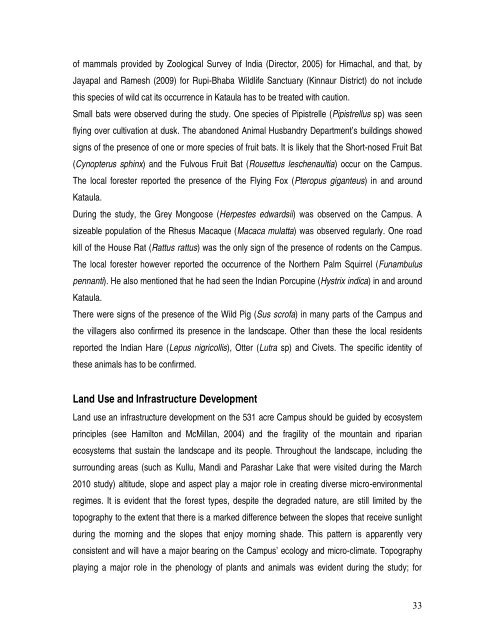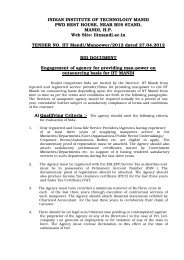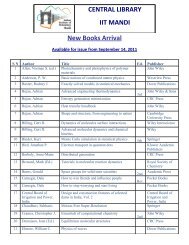Eco Report of the area - IIT Mandi
Eco Report of the area - IIT Mandi
Eco Report of the area - IIT Mandi
Create successful ePaper yourself
Turn your PDF publications into a flip-book with our unique Google optimized e-Paper software.
<strong>of</strong> mammals provided by Zoological Survey <strong>of</strong> India (Director, 2005) for Himachal, and that, by<br />
Jayapal and Ramesh (2009) for Rupi-Bhaba Wildlife Sanctuary (Kinnaur District) do not include<br />
this species <strong>of</strong> wild cat its occurrence in Kataula has to be treated with caution.<br />
Small bats were observed during <strong>the</strong> study. One species <strong>of</strong> Pipistrelle (Pipistrellus sp) was seen<br />
flying over cultivation at dusk. The abandoned Animal Husbandry Department’s buildings showed<br />
signs <strong>of</strong> <strong>the</strong> presence <strong>of</strong> one or more species <strong>of</strong> fruit bats. It is likely that <strong>the</strong> Short-nosed Fruit Bat<br />
(Cynopterus sphinx) and <strong>the</strong> Fulvous Fruit Bat (Rousettus leschenaultia) occur on <strong>the</strong> Campus.<br />
The local forester reported <strong>the</strong> presence <strong>of</strong> <strong>the</strong> Flying Fox (Pteropus giganteus) in and around<br />
Kataula.<br />
During <strong>the</strong> study, <strong>the</strong> Grey Mongoose (Herpestes edwardsii) was observed on <strong>the</strong> Campus. A<br />
sizeable population <strong>of</strong> <strong>the</strong> Rhesus Macaque (Macaca mulatta) was observed regularly. One road<br />
kill <strong>of</strong> <strong>the</strong> House Rat (Rattus rattus) was <strong>the</strong> only sign <strong>of</strong> <strong>the</strong> presence <strong>of</strong> rodents on <strong>the</strong> Campus.<br />
The local forester however reported <strong>the</strong> occurrence <strong>of</strong> <strong>the</strong> Nor<strong>the</strong>rn Palm Squirrel (Funambulus<br />
pennanti). He also mentioned that he had seen <strong>the</strong> Indian Porcupine (Hystrix indica) in and around<br />
Kataula.<br />
There were signs <strong>of</strong> <strong>the</strong> presence <strong>of</strong> <strong>the</strong> Wild Pig (Sus scr<strong>of</strong>a) in many parts <strong>of</strong> <strong>the</strong> Campus and<br />
<strong>the</strong> villagers also confirmed its presence in <strong>the</strong> landscape. O<strong>the</strong>r than <strong>the</strong>se <strong>the</strong> local residents<br />
reported <strong>the</strong> Indian Hare (Lepus nigricollis), Otter (Lutra sp) and Civets. The specific identity <strong>of</strong><br />
<strong>the</strong>se animals has to be confirmed.<br />
Land Use and Infrastructure Development<br />
Land use an infrastructure development on <strong>the</strong> 531 acre Campus should be guided by ecosystem<br />
principles (see Hamilton and McMillan, 2004) and <strong>the</strong> fragility <strong>of</strong> <strong>the</strong> mountain and riparian<br />
ecosystems that sustain <strong>the</strong> landscape and its people. Throughout <strong>the</strong> landscape, including <strong>the</strong><br />
surrounding <strong>area</strong>s (such as Kullu, <strong>Mandi</strong> and Parashar Lake that were visited during <strong>the</strong> March<br />
2010 study) altitude, slope and aspect play a major role in creating diverse micro-environmental<br />
regimes. It is evident that <strong>the</strong> forest types, despite <strong>the</strong> degraded nature, are still limited by <strong>the</strong><br />
topography to <strong>the</strong> extent that <strong>the</strong>re is a marked difference between <strong>the</strong> slopes that receive sunlight<br />
during <strong>the</strong> morning and <strong>the</strong> slopes that enjoy morning shade. This pattern is apparently very<br />
consistent and will have a major bearing on <strong>the</strong> Campus’ ecology and micro-climate. Topography<br />
playing a major role in <strong>the</strong> phenology <strong>of</strong> plants and animals was evident during <strong>the</strong> study; for<br />
33
















